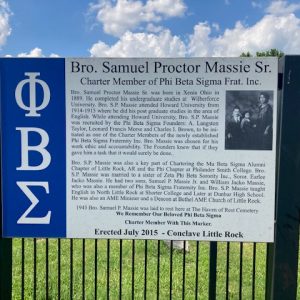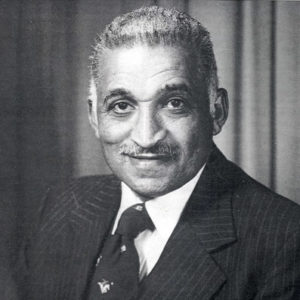calsfoundation@cals.org
Samuel Proctor Massie Jr. (1919–2005)
Samuel Proctor Massie Jr. overcame racial barriers to become one of America’s greatest chemists in research and teaching. As a doctoral candidate during World War II, he worked on the Manhattan Project with Henry Gilman at Iowa State University in the development of uranium isotopes for the atomic bomb. In 1966, the U.S. Naval Academy appointed him as its first black faculty member. Massie’s research over fifty years led to the development of drugs to treat mental illness, malaria, meningitis, gonorrhea, herpes, and cancer. Chemical and Engineering News in 1998 named him one of the top seventy-five chemists of all time, along with Marie Curie, Linus Pauling, George Washington Carver, and DNA pioneers James Watson and Francis Crick.
Samuel Massie was born on July 3, 1919, to school teachers Samuel Proctor Massie Sr. and Earlee Jacko Massie of North Little Rock (Pulaski County). He had one younger brother. He quickly advanced to high school and graduated second in his class from Dunbar High School in Little Rock (Pulaski County) by age thirteen. Early on, he wanted to be a chemist to find a cure for his father’s asthma.
After working for a year at Horton’s Grocery Store across the street from his home in North Little Rock, Massie had saved enough to afford tuition of $15 per semester at Dunbar Junior College. A year later, in 1934, the University of Arkansas (UA) in Fayetteville (Washington County) turned down his application for admission because he was black. He enrolled at Arkansas AM&N (now the University of Arkansas at Pine Bluff); earned a bachelor’s degree in chemistry with a minor in mathematics in 1937; and, with the aid of a federal National Youth Administration scholarship, finished a master’s degree in chemistry in 1940 at Fisk University in Nashville, Tennessee. He taught a year at Arkansas AM&N before gaining admission to a doctorate program in chemistry at Iowa State University.
Racial discrimination did not make Massie’s life any easier in Iowa. The closest housing available for African Americans was three miles from campus, requiring him to hitchhike to classes. He noted that he was assigned to a separate lab space “next to the rats in the basement” until he proved himself.
But he almost did not get to complete his doctoral program. Massie returned to Arkansas in 1943 to attend his father’s funeral and to renew his draft deferment. According to his autobiography, a member of the draft board in Pine Bluff (Jefferson County) decided that he had too much education for a black man and would be drafted. Massie quickly contacted Dr. Gilman, who assigned him to his research team working on the atomic bomb. In 1946, Massie received his PhD in organic chemistry at Iowa State and took a teaching position at Fisk, having published seven research papers with Gilman in the Journal of the American Chemical Society.
In 1947, Massie married Gloria Bell Thompkins, whom he had met at Fisk. She became a psychology professor, and the couple had three sons. Massie taught at Langston University in Langston, Oklahoma, from 1947 to 1953 and again at Fisk from 1953 to 1960. In 1954, he published “The Chemistry of Phenothiazine,” an article in Chemical Review that led to a breakthrough by French chemists in development of the anti-psychotic drug Thorazine. Work followed at the National Science Foundation and Howard University in Washington DC in the early 1960s. The Manufacturing Chemists Association recognized Massie in 1961 as one of the six best chemistry teachers in America. He served as president of North Carolina College in Durham for four years prior to his appointment in 1966 as professor of chemistry at the U.S. Naval Academy in Annapolis, Maryland, where he was the first black faculty member. In 1970, UA awarded Massie an honorary Doctor of Laws degree.
Massie retired from the Naval Academy in 1993. During his tenure there, he served on the academy’s equal employment opportunity committee and helped establish a black studies program. His portrait was hung in the National Academy of Sciences Gallery in 1995. In 1994, the U.S. Department of Energy created the Dr. Samuel P. Massie Chair of Excellence, a $14.7 million grant to nine historically black colleges and one for Hispanic students to further environmental research.
Massie died in Laurel, Maryland, on April 10, 2005, and is buried at St. Anne’s Cemetery in Annapolis, Maryland.
For additional information:
Lamb, Yvonne Shinhoster. “Prof. Samuel Massie Dies; Broke Naval Academy’s Race Barrier.” Washington Post. April 15, 2005, p. 6B.
Massie, Samuel Proctor, with Robert C. Hayden. Catalyst: The Autobiography of an American Chemist. Laurel, MD: S. P. Massie, 2001.
Sallee, Bob. “Backward Glances: Stellar Chemist Is a Legend in His Own Time.” Arkansas Democrat-Gazette. April 7, 1998, p. 4E.
Thompson, Neal. “The Chemist: An Interview with Samuel P. Massie.” American Legacy 7 (Spring 2001): 49–53.
Cary Bradburn
North Little Rock History Commission
 Arkansas Black Hall of Fame
Arkansas Black Hall of Fame Science and Technology
Science and Technology World War II through the Faubus Era, 1941 through 1967
World War II through the Faubus Era, 1941 through 1967 Massie Sr. Plaque
Massie Sr. Plaque  Samuel Massie
Samuel Massie 




Samuel Massie Jr. was a very good person. He didn’t give up when they tried to kick him out of college. He kept trying so he could improve.